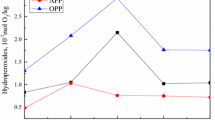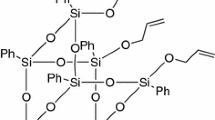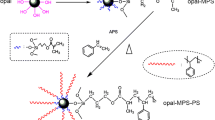Abstract
Novel organic/inorganic hybrid polyphosphazenes were prepared by free radical UV copolymerization of linear polyphosphazenes and vinyl monomers. In this work, linear polyphosphazenes grafted by allyl amino and n-butylamino groups have been synthesized via nucleophilic substitution reaction at an anhydrous and anaerobic atmosphere. By regulating the molar ratio of allyl amino and n-butylamino groups, five different linear polyphosphazenes were prepared. The hybrid polyphosphazenes have been crosslinked using the linear polyphosphazenes and vinyl monomers including styrene, methyl methacrylate, and lauryl methacrylate as intermediates via free radical UV copolymerization. By changing the quantity of vinyl monomers participating in the crosslinking reaction, series of hybrid polyphosphazene membranes were obtained. The linear polyphosphazenes have been characterized by Nuclear magnetic resonance, Fourier transform infrared (FTIR), Thermogravimetric analysis (TGA), Differential scanning calorimeter, Dynamic mechanical analyzer and Drop Shape Analysis (DSA). The hybrid polyphosphazenes have also been studied via FTIR, TGA and DSA. The test results proved that the linear polymers were successfully synthesized. Moreover, the water contact angles showed that the hybrid crosslinked polyphosphazenes had a better hydrophobicity and thermal stability than the linear polyphosphazenes and the hydrophobicity of hybrid membranes have a regular changing tendency with the quantities of UV-monomers and ratio of allylamino. The initial decomposition temperatures of the hybrid polymers also had a regular change due to the difference and quantities of vinyl monomers.









Similar content being viewed by others
References
Allcock HR, Maher AE, Ambler CM (2003) Side group exchange in poly(organophosphazenes) with fluoroalkoxy substituents. Macromolecules 36:5566–5572
Allcock HR (2003) Chemistry and applications of polyphosphazenes, vol 1. Wiley, Hoboken
Weikel AL, Krogman NR, Nguyen NQ, Nair LS, Laurencin CT, Allcock HR (2009) Polyphosphazenes that contain dipeptide side groups: synthesis, characterization, and sensitivity to hydrolysis. Macromolecules 42:636–639
Morozowich NL, Weikel AL, Nichol JL, Chen C, Nair LS, Laurencin CT, Allcock HR (2011) Polyphosphazenes containing vitamin substituents: synthesis, characterization, and hydrolytic sensitivity. Macromolecules 44:1355–1364
Chen C, Liu X, Tian ZC, Allcock HR (1994) Trichloroethoxy-substituted polyphosphazenes: synthesis, characterization, and properties. Macromolecules 45:9085–9091
Allcock HR, Smith DE, Kim YB (1994) Poly(organophosphazenes) containing allyl side groups: crosslinking and modification by hydrosilylation. Macromolecules 27:5206–5215
Minto F, Gleria M, Bertani R, Noto VD, Vidali M (1998) Photochemical behavior of poly(organophosphazenes). 15. Light-induced cross-linking of [(4-benzoylphenoxy) x (methoxyethoxyethoxy)2− x ] phosphazene copolymers. J Inorg Organom Polym 8:67–68
Deng M, Nair LS, Nukavarapu SP, Jiang T, Kanner WA, Li XD, Kumbar SG, Weikel AL, Krogman NR, Allcock HR, Laurencin CT (2010) Dipeptide-based polyphosphazene and polyester blends for bone tissue engineering. Biomaterials 31:4898–4908
Barrett EW, Phelps MVB, Silva RJ, Gaumond RP, Allcock HR (2005) Patterning poly(organophosphazenes) for selective cell adhesion applications. Biomacromolecules 6:1689–1697
Krogman NR, Weikel AL, Kristhart KA, Nukavarapu SP, Deng M, Nair LS, Laurencin CT, Allcock HR (2009) The influence of side group modification in polyphosphazenes on hydrolysis and cell adhesion of blends with PLGA. Biomaterials 30:3035–3041
Taylor TJ, Soto AP, Huynh K, Lough AJ, Swain AC, Norman NC, Russell CA, Manners I (2010) Synthesis of poly(alkyl/arylphosphazenes) via the ambient temperature phosphite-mediated chain-growth polycondensation of (N-silyl)bromophosphoranimines. Macromolecules 43:7446–7452
Chen-Yang YW, Hwang JJ, Huang AY (2000) Polyphosphazene electrolytes. 2. Synthesis and properties of new polymer electrolytes based on poly((amino)[(2-methoxyethoxy)ethoxy])phosphazenes. Macromolecules 33:1237–1244
Gleria M, Minto F, Po R, Cardi N, Fiocca L, Spera S (1998) Thermally induced grafting reactions of maleates containing oxazoline groups onto aryloxy–substituted poly(organophosphazenes). Macromol Chem Phys 199:2477–2487
Allcock HR, Dembek AA, Kim C (1991) Second-order nonlinear optical poly(organophosphazenes): synthesis and nonlinear optical characterization. Macromolecules 24:1000–1010
Allcock HR, Kugel RL (1965) Synthesis of high polymeric alkoxy- and aryloxyphosphonitriles. J Am Chem Soc 87:4216–4217
Allcock HR, Kugel RL (1966) Phosphonitrilic compounds. VII. High molecular weight poly(diaminophosphazenes). Inorg Chem 5:1716–1718
Allcock HR, Kugel RL, Valan KJ (1966) Phosphonitrilic compounds. VI. High molecular weight poly(alkoxy- and aryloxyphosphazenes). Inorg Chem 5:1709–1715
Cheng XJ, Peng C, Zhang DH, Liu SZ, Zhang AQ, Huang H, Lian JS (2013) A facile method for the preparation of thermally remendable cross-linked polyphosphazenes. J Polym Sci Part A: Polym Chem 51:1205–1214
Huang X, Huang XJ, Yu AG, Wang C, Dai ZW, Xu ZK (2011) “Click Chemistry” as a facile approach to the synthesis of polyphosphazene glycopolymers. Macromol Chem Phys 212:272–277
Lee SB, Song S (2005) Hydrolysis-improved thermosensitive polyorganophosphazenes with α-amino-ω-methoxy-poly(ethylene glycol) and amino acid esters as side groups. Polym Int 54:1225–1232
Jaglowskit AJ, Singler RE, Atkins EDT (1995) Liquid crystalline behavior of poly[((6-(4-phenylphenoxy)hexyl)oxy)(trifluoroethoxy)phosphazene]. Macromolecules 28:1668–1672
Allcock HR, Kim C (1991) Photochromic polyphosphazenes with spiropyran units. Macromolecules 24:2846–2851
Zheng L, Lu HQ, Fan HS, Zhang XD (2013) Reinforcement and chemical cross-linking in collagen-based scaffolds in cartilage tissue engineering: a comparative study. Iran Polym J 22:833–842
Allcock HR, Austin PE, Neenan TX (1982) Phosphazene high polymers with bioactive substituent groups: prospective anesthetic aminophosphazenes. Macromolecules 15:689–693
Huang XB, Yin L, Tang XZ (2008) Synthesis and characterization of a new organic-inorganic hybrid polyphosphazene polymer. Sci China Ser B-Chem 51:46–50
Allcock HR, Cameron CG (1994) Synthesis and characterization of photo-cross-linkable small-molecule and high-polymeric phosphazenes bearing cinnamate groups. Macromolecules 27:3125–3130
Huang YW, Pan Y, Fu JW, Huang XB, Tang XZ (2009) Study of crosslinking of polyphosphazene with allyl pendant groups initiated by benzoyl peroxide. J Appl Polym Sci 113:2353–2360
Lee SC, Chang JY (2009) Preparation of molecularly imprinted polymers using photo-cross-linkable polyphosphazene and selective rebinding of amino acids. Macromol Res 17:522–527
Allcock HR, Steely LB, Singh A (2006) Hydrophobic and superhydrophobic surfaces from polyphosphazenes. Polym Int 55:621–625
Chaudhuri S, Chakraborty R, Bhattacharya P (2013) Optimization of biodegradation of natural fiber (Chorchoruscapsularis): HDPE composite using response surface methodology. Iran Polym J 22:865–875
Yan ZL, Liu WQ, Gao N, Sun Y, Chen HS (2012) Surface properties of the epoxy resin modified by a novel functional fluorinated oligomer. Iran Polym J 21:721–730
Doi M (1997) Introduction to polymer physics [M]. Clarendon Press, Oxford, Eng
Acknowledgments
The authors would like to thank the financial support of NSFC (41240026) and Scientific Research Foundation for the Returned Overseas Chinese Scholars, State Education Ministry.
Author information
Authors and Affiliations
Corresponding author
Rights and permissions
About this article
Cite this article
Hu, L., Zhang, A., Yu, Y. et al. Synthesis of hybrid crosslinked polyphosphazenes and investigation of their properties. Iran Polym J 23, 689–698 (2014). https://doi.org/10.1007/s13726-014-0263-6
Received:
Accepted:
Published:
Issue Date:
DOI: https://doi.org/10.1007/s13726-014-0263-6




